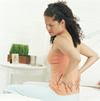 Many people believe that exercise is not really good for them unless they feel hyperstimulated or have some background fatigue, which they often identify as relaxing because they have worn out their muscles. Over exercising and the stresses that ensue lead to metabolic changes from the creation of more free radicals that age all our cells. We also get micro-tears in our connective tissues and micro-fractures in our skeletons, which contribute to lost mobility over time and can lead to premature aging.
Many people believe that exercise is not really good for them unless they feel hyperstimulated or have some background fatigue, which they often identify as relaxing because they have worn out their muscles. Over exercising and the stresses that ensue lead to metabolic changes from the creation of more free radicals that age all our cells. We also get micro-tears in our connective tissues and micro-fractures in our skeletons, which contribute to lost mobility over time and can lead to premature aging.
Most people can withstand substantial injuries early in their life and make remarkable comebacks with relatively short recovery times. As we get older, it becomes more important to avoid injuries, because it is more difficult to heal and an injury can have ramifications beyond the ability to do a workout routine. For example, sustaining an injury to your knee that prevents you from getting up and down from the floor easily or climbing your stairs can become a significant life-changing event if it causes long-term pain that affects your job, your relationships, and even your living quarters. I had a client who ran and rock-climbed regularly, but then seriously injured his knee. Although he continued to do the activities that were familiar and enjoyable to him for a while, eventually he couldn’t even make it up the stairs. By learning some of the movements in the Change Your Age Program, he was able to go up and down stairs without pain and then return to the activities he enjoyed.
Overstressing during exercise can create additional stresses to the joints and ligaments of the body. Your ligaments connect one bone to another and connect your skeleton together. If you had no muscles or tendons (which connect your muscles to your bones), you would still be held together by your ligaments. Forceful movement done too frequently has an effect on a ligament similar to taking a fresh, taut rubber band and pulling it apart and together repeatedly or pulling the band apart to its limit and keeping it there for too long. The band, like your ligaments, loses elasticity, and a ligament with less elasticity can weaken the bone-to-bone connections in your body.
In my work, I see highly skilled athletes, weekend athletes, and sports enthusiasts as well as well-renowned dance teachers and yoga instructors. Many of them come to me because of injuries they have sustained doing their favorite activities.
Many yoga teachers have stretched for too long or too far and, slowly, lengthened their ligaments. When we stretch too much, our ligaments become loose so our joints become too loose and they lose their stability. This unstable joint condition, known as hypermobility, arises from moving the joint too far and too often.
Similarly, runners, as they get older, find themselves getting tight in the calves and hamstrings, developing knee injuries, and then having to do a lot of stretching to help defray the feeling of tightness.
“Boomeritis,” named in 1999 by Dr. Nicholas A. DiNubile, an orthopedic surgeon at the Hospital of the University of Pennsylvania, is a national phenomenon witnessed by many physicians. Their baby boomer patients have returned to exercising, but they are exercising in the only way they’re familiar with, which is the exercise they knew in their twenties and thirties. The -itis in boomeritis refers to the mass inflammation of muscles, tendons, and joints that usually results in the breakdown of muscles and the supporting organs of the body, like the heart and kidneys, which are necessary to process the full metabolic and physiological effects of exercise on the body. Boomeritis can be completely avoided, however, by starting slower, using less force, and, if you’re following the exercise instructions of a personal trainer, listening only to someone who is trained in working with older adults. You’ll find one of the best ways to return to moving your body in the slow, inventive, and unusual movements of Chapter 3.
Here are four quick questions to help you assess whether overstressing is a problem in your exercise routines:
- Do you exercise beyond the point of pain and stress?
- Do you feel that you have not exercised enough if you don’t feel pain?
- While you exercise, do you feel yourself straining?
- How do you feel the next day?
Excerpted from Change Your Age, Chapter 1: How to Assess Your Current Exercise Program
For more movement lessons, tips and helpful routines, buy the Change Your Age book and the Change Your Age video program.
